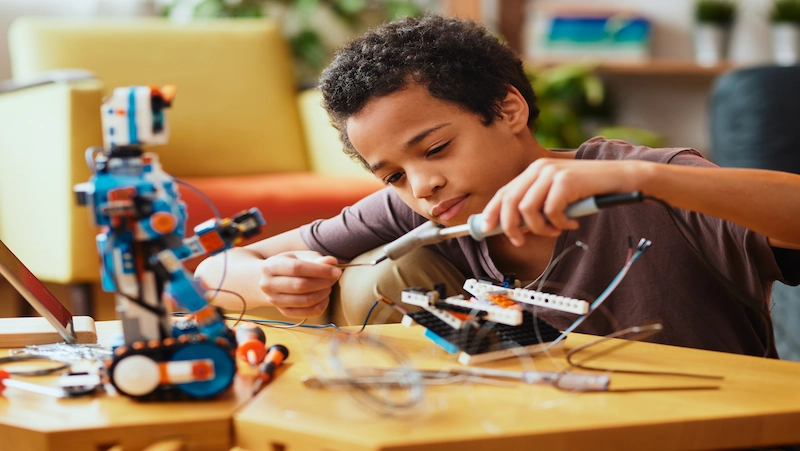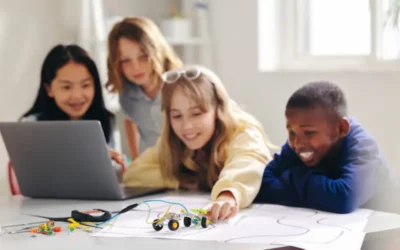Welcome to the exciting world of Robotics Class for Kids! In this innovative program, we aim to inspire and empower young minds to explore the wonders of Science, Technology, Engineering, and Mathematics (STEM) through robotics.
By introducing robotics at an early age, we nurture curiosity, critical thinking, and problem-solving skills, preparing children for the challenges of the future. Join us on this captivating journey where creativity meets cutting-edge technology, as we pave the way for a new generation of young inventors and engineers. Let’s embark on an adventure that combines learning, fun, and endless possibilities!
Table of contents
Introduction

In today’s fast-paced technological world, it is crucial to equip our children with the skills necessary to navigate the future successfully. One field that has gained significant popularity in recent years is robotics. Robotics classes for kids offer an engaging and interactive learning experience that goes beyond just playing with robots.
These classes provide a unique opportunity for children to explore science, technology, engineering, and mathematics (STEM) while fostering creativity and problem-solving skills. Let’s dive into the exciting world of robotics classes for kids and discover why they are becoming increasingly popular.
Learning by Doing:
The emphasis on doing is one of the key benefits of robotics education for kids. Children can build, program, and experiment with real robots. They are better able to comprehend abstract ideas and use them in practical situations thanks to this practical approach.
Children gain a greater comprehension of the basics of robotics, mechanics, and electronics by actively engaging in the process.
STEM Integration:
Robotics lessons offer youngsters a comprehensive educational experience by effortlessly integrating multiple STEM topics. Kids can study physics, arithmetic, computer programming, and engineering principles in a fun and engaging way with robotics.
They learn how these fields interact to form complex systems, which encourages the use of multiple disciplinary perspectives when solving problems.
Creativity and Innovation:
Robotics programming for kids encourages children’s ingenuity and creativity. Because designing and creating robots forces kids to think creatively, it inspires them to investigate novel concepts and approaches.
Critical Thinking and Problem-Solving Skills:
Children’s critical thinking and problem-solving abilities are developed in robotics classes. They gain the ability to analyze issues, find potential solutions, and make wise decisions as they face difficulties and obstructions.
They learn tenacity, perseverance, and the capacity to overcome obstacles through trial and error—a crucial skill set that transcends robotics and applies to many facets of life.
Teamwork and Collaboration:
Numerous robotics classes like Lego Robotics for kids promote children’s cooperation and teamwork. Children gain an appreciation for the value of effective communication, teamwork, and idea-sharing when working in groups.
They are aware that each contributor is essential to reaching the group’s objective. Leadership, empathy, and respect for various viewpoints are just a few of the crucial social skills that may be developed in this cooperative setting.
Getting Ready for the Future:
Robotics classes provide children with a glimpse into the future of technology. They learn about modern innovations like artificial intelligence, automation, and autonomous systems.
Children build a solid basis for future professions in STEM subjects by being exposed to this new technology at a young age. They also acquire flexibility and a growth attitude, enabling them to accept change and maintain their agility in a constantly changing world.
Benefits of Robotics Classes for Kids

In today’s rapidly advancing technological landscape, it’s crucial to equip children with the skills and knowledge they need to thrive in the future. One such skill that is gaining immense popularity and significance is robotics.
Robotics classes for kids offer an engaging and hands-on learning experience that fosters creativity, problem-solving abilities, and critical thinking skills. Let’s delve into the captivating world of robotics and explore the myriad of benefits it offers to young learners.
Cultivating Creativity and Imagination:
Robotics lessons offer the perfect setting for kids to let their imaginations run wild and their creativity soar. Kids are inspired to think creatively and develop novel solutions to issues by creating robots and programming them to carry out specified duties.
They are given the flexibility to experiment, iterate, and actualize their ideas as they design and build their own robots, developing their creative potential.
Developing Problem-Solving Skills:
Because robots don’t always behave as they should, kids have a great chance to practice problem-solving techniques, which are an essential part of positive thinking for kids. Young learners must evaluate the scenario, identify the issue, and use logical reasoning to troubleshoot and fix it when they are faced with obstacles or problems.
Children learn resilience and tenacity through this iterative process of trial and error, which also sharpens their critical thinking skills.
Enhancing STEM Proficiency:
Through practical exercises, children can learn about principles in mechanics, electronics, programming, and even physics. They gain practical information that supplements the theoretical ideas taught in conventional classrooms by actively participating in robotics, which promotes a deeper understanding of STEM fundamentals.
Fostering Teamwork and Collaboration
Robotics often involves team projects, where children collaborate with their peers to solve complex challenges. Working in groups promotes efficient communication, teamwork, and idea-sharing.
Kids who take team-based robotics lessons and who join robotics camps for kids gain leadership qualities, an appreciation for the value of collaboration, and knowledge of teamwork. These crucial interpersonal skills positively impact their total development—both personally and academically.
Increasing Self-Assurance and Resilience
Robotics classes provide a supportive environment where children can experiment and take risks without the fear of failure. They gain confidence and a resilient mindset as they complete tasks and conquer challenges.
Teaching children that setbacks are opportunities for progress, failure becomes an integral part of the process. Children are now more resilient and self-assured, and they are more equipped to face obstacles outside of the robotics world.
Promoting Future Career Research:
Early exposure to robotics provides a variety of job opportunities because robotics is a crucial component of many businesses. Robotics programs pique students’ interest and passion, encouraging them to consider careers in engineering, programming, artificial intelligence, or even robotics research as potential future professions.
Children are better prepared to negotiate the future job market and take advantage of opportunities in emerging sectors by building a solid foundation in robotics.
How to Choose the Right Robotics Class for Your Kids

As a parent, it is essential to foster your child’s interest in science, technology, engineering, and mathematics (STEM) subjects. Robotics classes can be an excellent way to introduce your kids to the exciting world of technology and inspire them to become future innovators.
However, with numerous options available, it can be overwhelming to choose the right robotics class for your children. This blog post will guide you through the process, helping you make an informed decision.
Find out your child’s interests and objectives:
It’s critical to comprehend your child’s interests and goals before choosing a robotics class. While some kids could be more interested in coding and programming, others might be more inclined toward designing and building robots.
Finding a class that fits your child’s interests will enable them to completely engage and enjoy the learning process. This can be done by evaluating your child’s preferences.
Examine the programs that are offered:
Once you are certain of your child’s interests, look into the robotics programs that are offered in your neighborhood. Find trustworthy organizations, after-school activities, or specialized robotics academies that provide instruction for various age groups and ability levels.
Look through their websites, read reviews, and ask other parents or instructors who have used them for advice.
Examine the curriculum:
Examine the teaching staff:
Your child’s educational experience may be considerably impacted by the caliber of the teachers. Make sure the instructors of the robotics class you select are skilled, competent, and enthusiastic in instructing robotics to kids. Fun & educational activities for kids are essential in these classes, as complex ideas can be efficiently conveyed in an interesting and age-appropriate fashion by a trained instructor.
Consider the resources and equipment:
A successful robotics class should give students access to the tools and supplies they need for practical instruction. Examine the program’s robotics lab or workshop to see if it is well-stocked with a range of robotics kits, parts, and software tools.
Your youngster will learn about numerous robotics topics and be given access to a variety of projects and challenges thanks to a wide variety of materials.
Class size and individual attention:
Smaller class sizes are frequently associated with higher levels of student engagement and individualized care. Take into account the instructor-to-student ratio in the robotics course you’re interested in.
A smaller ratio makes sure that your child receives individualized coaching and support, promoting their robotics learning and development.
Competitions and extracurricular activities:
Robotics contests and extracurricular activities provide your child additional chances to put their knowledge to use and show off their inventiveness, while also incorporating growth mindset activities for kids. Ask if the robotics class organizes its own robotics events or competes in nearby or regional tournaments.
Such endeavors can increase your child’s motivation, foster teamwork, and provide a stage for accolades and financial aid.
Cost and timetable:
As a final point, think about the robotics class’s price and schedule. Comparing the costs of various programs will help you determine whether they offer excellent value for the money given their respective curricula, resources, and level of competence.
Check to see if the class schedule works into your family’s routine and is compatible with your child’s other obligations.
Tips for Encouraging STEM Learning at Home

STEM (Science, Technology, Engineering, and Mathematics) education plays a vital role in shaping the minds of future innovators and problem solvers. While schools offer STEM programs, parents can also play a significant role in fostering their child’s interest in these subjects at home.
By creating a supportive environment and providing engaging opportunities, parents can encourage their children to explore and excel in STEM learning, while also sprinkling in fun facts for kids. In this blog post, we will discuss some practical tips for inspiring and nurturing STEM learning right in the comfort of your own home.
Integrate STEM into everyday activities:
One effective way to encourage STEM learning at home is to seamlessly integrate it into your everyday activities for kids. Incorporate scientific thinking, mathematical concepts, and problem-solving skills into daily routines. For instance, while cooking, involve your child in measuring ingredients, discussing chemical reactions, or exploring the physics of heat and temperature. This hands-on experience fosters a practical understanding of STEM concepts and makes learning more enjoyable.
Provide access to STEM resources:
Make sure your home is stocked with age-appropriate STEM resources such as books, educational toys, puzzles, and building blocks. These resources can stimulate curiosity and engage children in interactive learning experiences. Look for materials that encourage experimentation, critical thinking, and creativity.
Additionally, leverage the power of technology by exploring educational websites, apps, and online tutorials that offer engaging STEM content.
Encourage open-ended questioning and curiosity
Encourage your child to ask questions and be curious about the world around them. Foster a culture of inquiry by engaging in discussions and encouraging them to find answers independently.
Support hands-on exploration and experimentation:
STEM learning thrives on hands-on experiences. Provide opportunities for your child to explore and experiment with STEM concepts through projects, experiments, and challenges, including STEM activities for elementary students.
Set up a dedicated workspace with materials such as magnifying glasses, microscopes, circuits, or even a small garden for biology experiments. Engaging in hands-on activities fosters problem-solving skills, creativity, and resilience.
Foster collaboration and community involvement:
Encourage your child to collaborate with peers, siblings, or other family members on STEM projects. This not only enhances teamwork and communication skills but also provides an opportunity for knowledge sharing and learning from others.
Additionally, consider involving your child in community STEM initiatives, such as science fairs, robotics clubs, or volunteering at local science centers. Such experiences broaden their horizons and inspire a deeper interest in STEM fields.
Celebrate achievements and failures:
Acknowledge and celebrate your child’s efforts and achievements in STEM learning, while also teaching kids kindness. Praise their hard work, perseverance, and problem-solving skills. Additionally, teach them that failures are an essential part of the learning process.
Encourage them to learn from mistakes, iterate, and try again. By fostering a growth mindset, you empower them to embrace challenges and view setbacks as opportunities for growth.
Conclusion
In conclusion, the introduction of robotics classes for kids has proven to be an effective method for encouraging STEM learning at an early age. These classes provide children with valuable opportunities to explore and engage with science, technology, engineering, and mathematics in a hands-on and exciting way.
By introducing robotics concepts and principles, children develop essential skills such as problem-solving, critical thinking, teamwork, and creativity.
Robotics classes offer a unique learning environment where children can apply theoretical knowledge to practical tasks. They gain a deeper understanding of engineering and programming concepts by building and programming their own robots. This hands-on experience fosters a sense of curiosity and experimentation, nurturing their interest in STEM subjects.
By starting STEM education at an early age through robotics classes, we equip children with the foundational knowledge and skills necessary for success in the digital age. These classes cultivate a passion for learning and exploration, instilling in children a lifelong love for science, technology, engineering, and mathematics.
In conclusion, robotics classes for kids serve as a gateway to STEM education, igniting their curiosity, developing their skills, and shaping their future. By encouraging children to engage with robotics at an early age, we empower them to become critical thinkers, problem solvers, and innovators, ensuring a bright and promising future for the next generation.
Frequently Asked Questions
A robotics class for kids is an educational program designed to teach children about robotics, programming, and engineering concepts through hands-on activities and projects using robot kits or components.
Robotics classes are typically suitable for children in the age range of 8 to 16 years old, although some programs may have variations to accommodate younger or older students.
Taking a robotics class can provide numerous benefits for kids, including fostering creativity, problem-solving skills, teamwork, logical thinking, and a better understanding of technology and engineering concepts.
In a robotics class, children can learn various skills such as building and programming robots, understanding sensors and motors, coding, problem-solving, and critical thinking.
No, prior experience with robotics is not usually required to join a robotics class for kids. Most classes are designed to accommodate beginners and provide step-by-step instructions and guidance.
Robotics classes typically use robot kits or components, which may include building blocks, sensors, motors, microcontrollers, and programming software.
The duration of a typical robotics class for kids can vary, but it is often around 1 to 2 hours per session. The overall length of the program may range from a few weeks to several months, depending on the curriculum.
Robotics classes are usually taught by qualified instructors who have expertise in robotics, programming, and engineering. Some classes may also have guest speakers or industry professionals to provide additional insights.
Most robotics classes do not have strict prerequisites, and beginners are welcome. However, some programs may have age restrictions or recommend basic computer literacy skills.
The cost of a robotics class for kids can vary depending on factors such as the duration of the program, the quality of the materials provided, and the location. Prices can range from affordable to more expensive, so it’s best to check with specific program providers for accurate pricing information.
To enroll your child in a robotics class, you can typically visit the program’s website or contact the organizer directly. They will provide information on enrollment procedures, availability, and any required forms.
The class size for a robotics class can vary depending on the program and the available resources. Classes may range from small groups to larger settings, but many programs strive to maintain a reasonable student-to-instructor ratio to ensure personalized attention.
Many robotics classes provide certificates or recognition upon completion of the program. However, it may vary depending on the specific class or program. It is best to inquire about this directly with the organizers.
Some robotics classes offer follow-up programs or resources to further engage children in robotics and STEM activities. These may include advanced courses, workshops, online resources, or competitions that students can participate in.
Most robotics classes provide updates on your child’s progress throughout the program. You can typically expect regular communication, such as progress reports, parent-teacher meetings, or access to an online portal where you can monitor your child’s assignments and achievements.


 We are an army of educators and passionate learners from BrightChamps family, committed to providing free learning resources to kids, parents & students.
We are an army of educators and passionate learners from BrightChamps family, committed to providing free learning resources to kids, parents & students.








